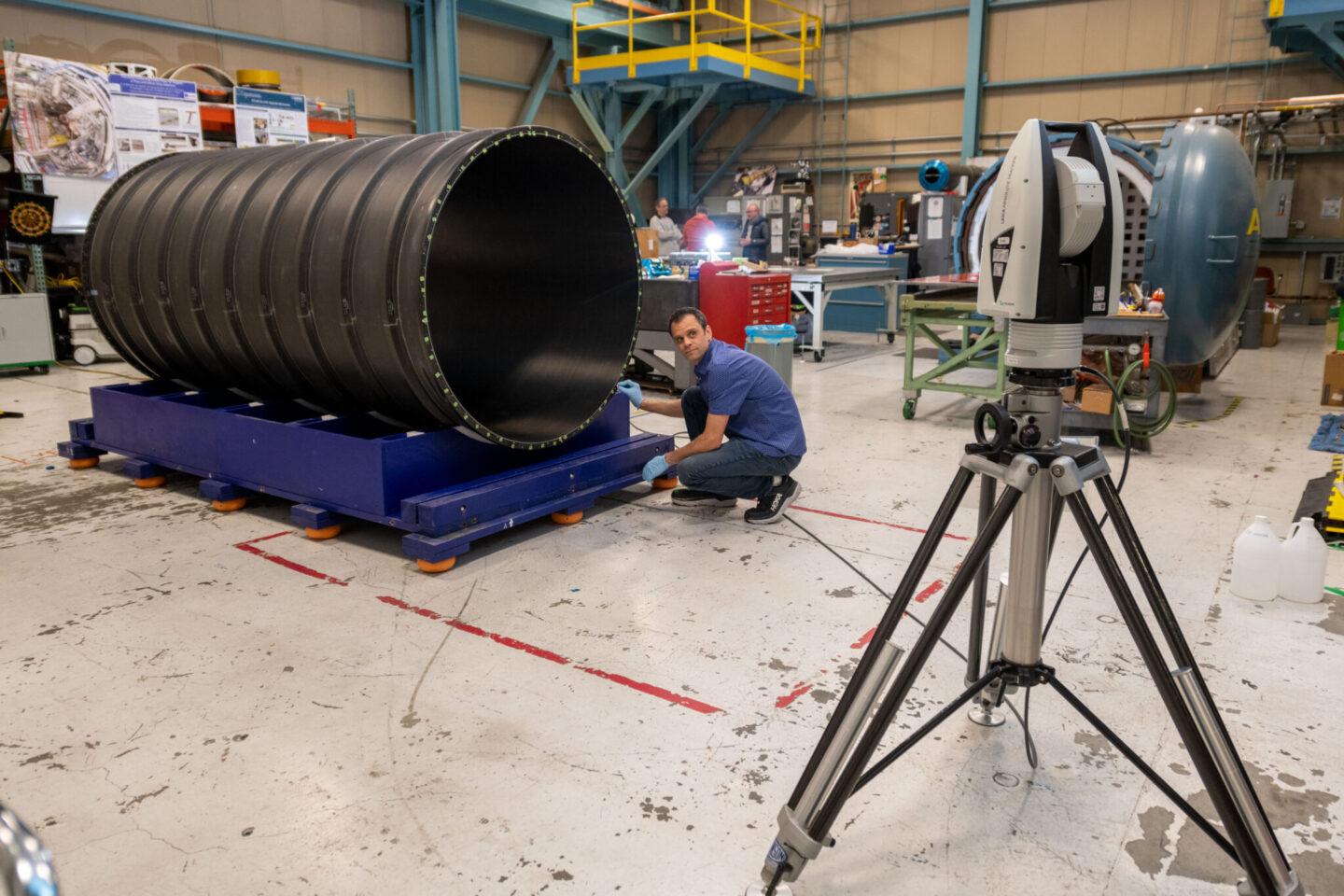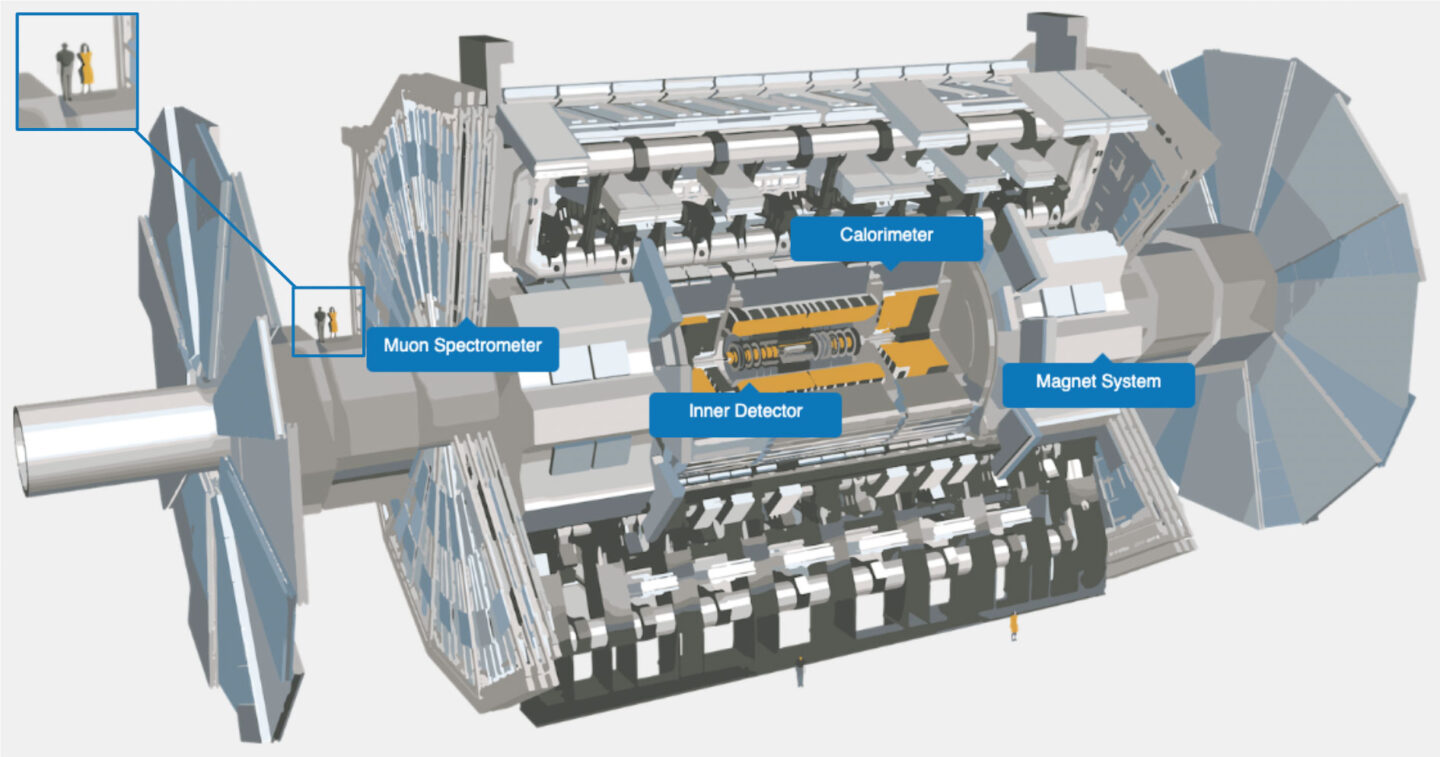Work has started on several of the large carbon composite structures that are now arriving at Berkeley Lab to be qualified before they are integrated into the ATLAS Experiment, part of the Large Hadron Collider (LHC) at CERN.
Several critical elements of ATLAS – including data acquisition electronics and silicon detector modules – are being designed, engineered, and fabricated by a collaboration of engineers and researchers in Berkeley Lab’s Engineering and Physics Divisions. Their work on upgrading the ATLAS Inner Detector is planned to coincide with the LHC’s upcoming luminosity upgrade, and the detector upgrade will be optimized to take advantage of the additional brightness in the collider, increasing the data rate by nearly ten-fold. During this coordinated process, the detector will also be refurbished and enhanced, after over 15 years of running.
The first two structures for the Inner Detector upgrade – called the ATLAS Inner Tracker (ITk) – have now arrived at Berkeley Lab. The ITk will eventually comprise several cylindrical carbon composite barrel structures ranging from 0.7 to 2.2 meters in diameter. These are being designed and built using cyanate-ester resins for stability and radiation tolerance, with ultra-high modulus carbon fiber material with moduli in the range of 600-800 GPa. When laid up with appropriate orientations, these yield a material with a modulus similar to titanium and a near-zero coefficient of thermal expansion. In each of the barrels, some of the laminates are as thin as 0.6 mm, with thicker reinforcements installed where heavier detector elements will be directly supported. Each barrel is able to support approximately 8-10 times its mass.

After the Layer 2 (L2) and Layer 3 (L3) Barrels, the next barrel to arrive at Berkeley Lab will be the Outer Cylinder, which will support the L2 and L3 Barrels as well as all of the technical equipment that will eventually be installed inside of them in the ITk. These outer barrels will be the first to arrive at CERN so that the ITk can be assembled from the outside in. The smaller inner barrels – L0 and L1 – will begin fabrication in summer 2023 using onsite equipment, and then be shipped to CERN for installation inside the ITk next year.
ITk Project Engineer Eric Anderssen, a mechanical engineering group lead in Berkeley Lab’s Engineering Division, said “These are exciting times for the ATLAS Upgrade project. We have started to receive the first structures that will be installed in the ATLAS detector at CERN in 2029. Five years ago these were just cartoons in a presentation, and these sketches led to proposals and the engineering team that designed them. It’s incredibly rewarding to physically see and touch what you imagined.”

In the early 2000s, Berkeley Lab established a composites lab to develop and produce structures that could support the ATLAS large silicon detectors, which require highly-stable integrated cooling systems to extract the heat being generated by faster ASICs (application-specific integrated circuits). This facility has since gone on to design and produce similar structures for the STAR, PHENIX, and ALICE experiments, as well as instruments for various light sources and other experiments with similar stability requirements for their detectors.
ATLAS first came online in 2009 as one of several experiments installed on the LHC at CERN in Geneva, Switzerland. The data collected contributed to the discovery of the Higgs Boson in 2012 and a subsequent Nobel Prize. Berkeley Lab first became involved with ATLAS in the mid-1990s, and the detectors developed at Berkeley Lab for the Super Conducting Supercollider were key to the future success of ATLAS and other LHC experiments. These detectors were the first large-scale implementation of integrated silicon trackers in excess of several square meters of silicon sensors with fast readout (40 MHz). Berkeley Lab scientists and engineers contributed first to developing the silicon ASICs for the detector and later to the support structures.

ATLAS is a worldwide collaboration of researchers who are designing and building a large multi-purpose detector to conduct particle physics experiments using head-on collisions of high-energy protons. The experiment’s advanced technology and precision instrumentation will enable researchers to better understand the basic components of matter and dark matter, the fundamental forces of nature, and other new discoveries about the nature of our Universe.
###
Berkeley Lab is a multiprogram national laboratory managed by the University of California for the U.S. Department of Energy’s Office of Science (DE-AC02-05CH11231). Berkeley Lab Engineering encompasses a broad range of unique expertise areas, collaborating across a global community of multi-disciplinary researchers to develop instrumentation solutions and technical approaches that address critical scientific problems. Our projects include the design and development of innovative semiconductor detectors, custom integrated circuits, mechanical systems, composite technologies, and complex fabrications, among others. For more information and to learn about job opportunities, visit https://engineering.lbl.gov/.